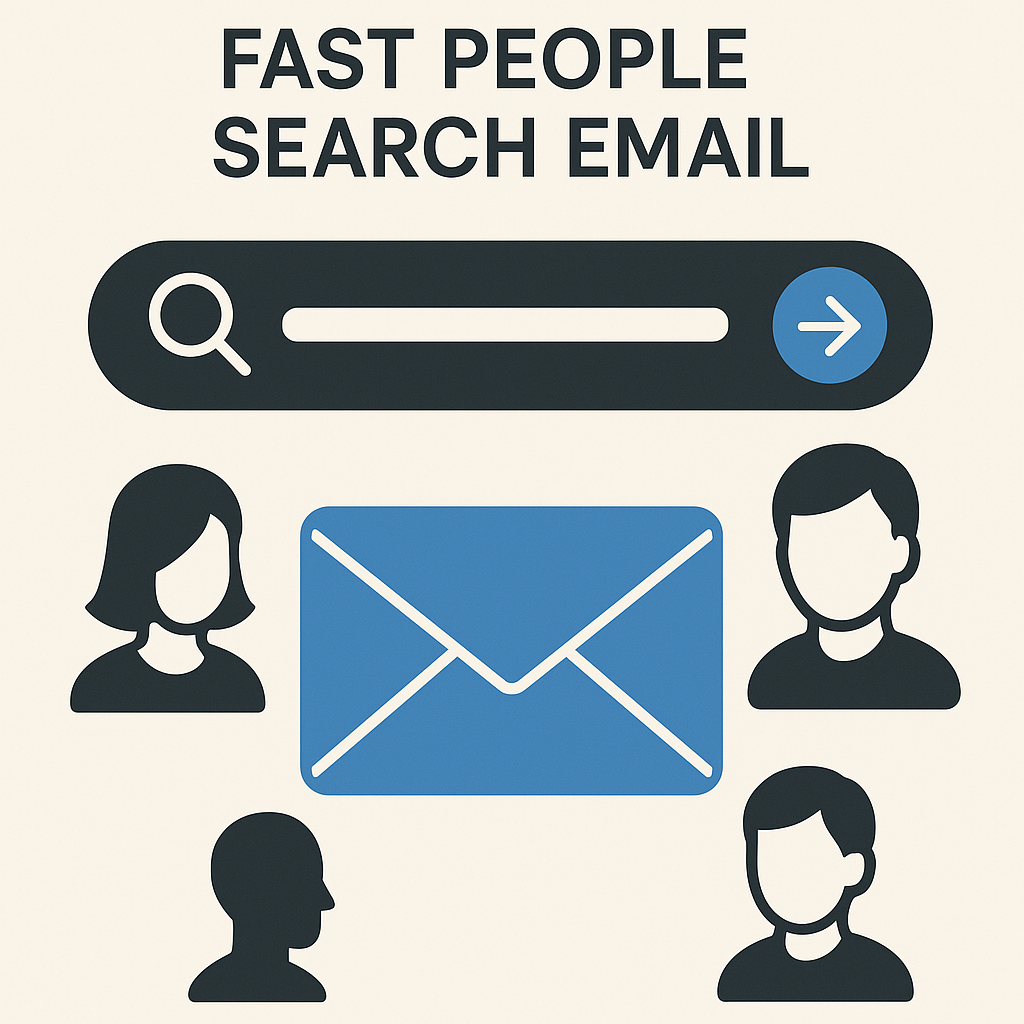Fast People Search Email: Boost Your Productivity

In the relentless flow of modern business communication, your inbox can quickly become a labyrinth. Every day, professionals sift through hundreds, sometimes thousands, of emails, each representing a task, a contact, or a potential opportunity. The ability to quickly locate a specific person, their contact details, or past correspondence is no longer a luxury – it's a fundamental requirement for maintaining productivity and achieving business goals. This is where the power of a fast people search email strategy comes into play. Wasting precious minutes, or even hours, digging through your inbox to find the right contact can derail your workflow, delay crucial decisions, and impact your response rates. For sales teams chasing leads, executives coordinating projects, or entrepreneurs managing client relationships, speed and accuracy in finding people within your email are paramount.
This article will equip you with the essential techniques and insights to master fast people search email. We'll explore how to leverage your existing email client's powerful search features, implement best practices for robust email contact management, and delve into advanced search methods. Crucially, we'll introduce you to the transformative capabilities of AI in revolutionizing how you search contacts in email, helping you reclaim your time and boost your overall email productivity tips.
Leveraging Your Email Client's Built-in Search Features Effectively
Before diving into advanced tools, it's essential to acknowledge the power already at your fingertips within your email client. Whether you're using Gmail, Outlook, Apple Mail, or another platform, robust search functionalities are designed to help you find email address quickly and locate specific communications. The key is to use them strategically.
1. Mastering Basic Search Queries: The most straightforward method is typing a name or company into the search bar. However, this often yields too many results. To refine your search, consider:
- Searching by Sender: Typing
from: [Name]orfrom: [[email protected]]will immediately narrow down results to emails sent by that specific person. This is invaluable for recalling conversations with a particular contact. - Searching by Recipient: Use
to: [Name]orto: [[email protected]]to find emails you sent to someone or emails where they were a primary recipient. - Subject Line Searches: If you remember a keyword from the subject, use
subject: [keyword]. For instance,subject: "Project Alpha Update"can quickly pull up all relevant project communications. - Date-Based Searches: Narrow down your search by date ranges. Use operators like
before: [date],after: [date], oron: [date]. For example,from: [email protected] after: 2023/01/01 before: 2023/06/30will show emails from Jane Doe within the first half of 2023.
2. Utilizing Keywords and Concepts: Beyond names and subjects, think about keywords related to the person or the topic of your communication. If you're trying to find someone you discussed a specific product with, search for the product name in conjunction with their name or company. This approach is fundamental to efficient email searching.
3. Leveraging Labels and Folders: While not strictly a search function, a well-organized inbox makes searching infinitely easier. If you consistently label or file emails from important contacts or projects, finding someone associated with a particular label can be as simple as clicking on that label. For those using Gmail, understanding how to organize emails on Gmail is a game-changer for efficient email management.
Best Practices for Organizing Contacts to Facilitate Quick Searches
A clean and organized contact list is the bedrock of any effective fast people search email strategy. Without proper business email organization and contact management, even the best search tools will struggle. Think of your contacts as a database; the cleaner the data, the faster and more accurate your queries.
1. Centralize Your Contacts: Avoid having contact information scattered across different platforms or sticky notes. Use your email client's built-in contact manager, a CRM system, or a dedicated contact management application. This ensures a single source of truth for all your professional connections.
2. Maintain Accurate and Complete Information: When adding a contact, ensure you include all relevant details:
- Full Name (First and Last)
- Primary Email Address
- Secondary Email Addresses (if applicable)
- Company Name
- Job Title
- Phone Numbers (Work, Mobile)
- Website/LinkedIn Profile URL
- Notes (e.g., how you met them, key project details, preferences)
3. Use Consistent Naming Conventions: Standardize how you enter names. For example, always use "John Doe" rather than sometimes "J. Doe" or "Johnny D." This consistency prevents duplicate entries and ensures your searches return accurate results.
4. Leverage Contact Groups or Lists: Many email clients allow you to create groups (e.g., "Sales Team," "Key Clients," "Project X Stakeholders"). This not only helps in sending mass emails but also in quickly identifying all contacts related to a specific team or project when you need to find someone within that context.
5. Regular Audits and Updates: People change jobs, companies merge, and contact details evolve. Schedule regular times (e.g., quarterly) to review your contact list, update outdated information, and remove defunct entries. This proactive approach is crucial for maintaining the integrity of your contact database and ensuring your fast people search email efforts are always fruitful.
Advanced Search Techniques: Using Filters and Operators for Precision
Once you've optimized your inbox and contact list, it's time to elevate your search game using advanced techniques. These methods allow for highly specific queries, cutting through the noise to find exactly what you need, enabling a truly fast people search email experience.
1. Combining Search Operators: The real power of email search lies in combining multiple operators. For example:
from: [Name] subject: "Proposal" after: [date]– Find all emails from a specific person with "Proposal" in the subject, sent after a certain date.to: me "project update" -marketing– Find emails sent to you containing "project update" but exclude those related to marketing campaigns.has:attachment filename:pdf from: [name]– Locate emails from a specific person that contain a PDF attachment.
Many email clients support a wide array of operators. Familiarizing yourself with these can dramatically improve your ability to find email address quickly or locate specific threads.
2. Using Wildcards (Where Supported): Some search functions allow wildcards, like an asterisk (*), to represent one or more characters. For example, searching for `Joh* Doe` might find "John Doe" and "Johan Doe." Check your email client's help documentation for supported wildcards.
3. Searching Within Specific Folders or Labels: If you've organized your email, you can often limit your search to specific folders or labels. This is incredibly effective for narrowing down results. For instance, searching within your "Clients" folder for a specific client's name will be much faster than a global search.
4. Leveraging Third-Party Search Tools: While built-in features are powerful, specialized tools can offer enhanced search capabilities, often with more intuitive interfaces or advanced filtering options. Resources like Indigo Marketing Agency's guide on email search tricks offer further insights into maximizing your search efficiency.
By mastering these advanced techniques, you transform email searching from a chore into a precise operation, a core component of efficient email searching.
Introducing AI: How AI Tools Can Revolutionize Your Email People Search
While manual search techniques and diligent organization are crucial, the most significant leap in achieving a truly fast people search email capability comes from artificial intelligence (AI). Traditional search relies on keywords and metadata. AI, on the other hand, can understand context, intent, and relationships within your communications, offering a far more intelligent and intuitive way to find people and information.
AI-powered email solutions can:
- Understand Natural Language: Instead of complex operators, you can ask questions like, "Find the last email from Sarah about the Q3 budget" or "Who did I discuss the partnership with last week?"
- Contextual Search: AI can analyze the content of your emails to understand the relationships between people, projects, and topics, even if you don't remember specific keywords.
- Predictive Search: As you type, AI can predict who you're looking for based on your recent activity, common contacts, and communication patterns, offering suggestions to speed up the process.
- Relationship Mapping: Advanced AI can help you visualize your professional network within your email history, making it easier to identify key stakeholders or find people connected to a particular contact.
- Automated Tagging and Categorization: AI can automatically tag emails and contacts based on content and sender, making future searches more targeted and faster. This ties directly into improving email productivity tips.
In today's fast-paced digital environment, efficiency is paramount. While mastering your email client's search functions and maintaining impeccable contact organization can save significant time, the true revolution in email productivity comes with the integration of artificial intelligence. Modern solutions, such as an ai executive assistant, are designed to go beyond simple keyword matching, understanding context, relationships, and intent to deliver lightning-fast results. These intelligent tools can predict who you're looking for, surface relevant past conversations, and even suggest optimal times for outreach, transforming your inbox from a data graveyard into a dynamic communication hub.
By embracing AI, you move from reactive searching to proactive information retrieval, significantly enhancing your ability to search contacts in email and boosting overall email productivity.
MailToPie's Solution: Fast and Intelligent Contact Discovery
MailToPie is at the forefront of leveraging AI to solve the persistent challenge of finding people and information within your email. It transforms your email inbox into a smart, searchable database, making a fast people search email a reality for busy professionals.
Here's how MailToPie excels:
- Intelligent Contact Recognition: MailToPie uses AI to go beyond simple name matching. It understands variations in how people might be referred to, identifies key individuals in email threads, and can surface their contact information even if it's not explicitly in your main contact list.
- Context-Aware Search: If you're looking for someone you discussed a specific project with, MailToPie can analyze the content of those conversations to pinpoint the relevant individuals, making it easier to find email address quickly.
- Relationship Discovery: The platform can highlight connections between contacts, showing you who communicates with whom about specific topics. This is invaluable for understanding your professional network and identifying key influencers or collaborators.
- Streamlined Workflow: By automating the process of finding contact details and relevant communication history, MailToPie significantly reduces the time spent on manual searching. This directly contributes to improved email productivity tips and more efficient email searching.
- AI-Powered Insights: MailToPie can offer insights into your communication patterns, helping you identify your most frequent contacts or people you haven't connected with recently, further enhancing your email contact management.
For professionals struggling with cluttered inboxes and the constant need to locate specific individuals, MailToPie offers a powerful solution. It acts as an intelligent layer over your existing email, ensuring that finding the right person is no longer a time-consuming obstacle but a swift, intuitive process. This aligns perfectly with the goals of improving business email organization and overall operational efficiency.
Tips for Sales & Marketing Professionals to Speed Up People Searches
For those in sales and marketing, the ability to perform a fast people search email is directly tied to revenue and client satisfaction. Every moment spent searching for a prospect's email, a decision-maker's contact information, or past communication details is a moment lost in nurturing a lead or closing a deal. Here are specific tips tailored for these roles:
1. Prioritize Lead Qualification Information: When a new lead comes in, immediately ensure their contact details are accurately saved. Use your CRM or contact manager to tag them by lead source, stage, and interest. This allows you to quickly search for all leads from a specific campaign or interested in a particular product.
2. Map Key Stakeholders:
For larger accounts or complex sales cycles, identify all key individuals involved (decision-makers, influencers, gatekeepers). Save their contact details, job titles, and even notes about their communication preferences. When you need to reach out to a specific role, like the Head of Procurement, a quick search for title:"Head of Procurement" or a search within a specific account's contact group can yield immediate results.
3. Track Past Interactions: Sales and marketing often involve follow-ups and relationship building over time. Use your search to quickly find the last email sent to a prospect, the outcome of a previous meeting, or any specific requests they made. This context is crucial for personalized outreach. Tools that facilitate efficient email searching are invaluable here. For instance, remembering a recent conversation about a specific feature can be enough to trigger a quick search that pulls up all relevant emails.
4. Leverage Email Response Speed: In sales, speed matters. A quick response to an inquiry can be the difference between winning a customer and losing them to a competitor. A fast people search email capability ensures you can find the right contact and their history to respond promptly. The economic value you're missing out on by slow responses is significant, as highlighted in discussions about email response speed value.
5. Utilize CRM Integration: Many modern sales and marketing tools integrate with email clients. Ensure your contact data is synced. This way, when you're looking for someone in your email, you can often find their CRM profile and associated communication history with a few clicks, streamlining your workflow and improving business email organization.
By making a fast people search email a core part of your daily workflow, sales and marketing professionals can significantly improve their outreach effectiveness, conversion rates, and overall productivity.
Conclusion: Mastering Fast Email People Search for Peak Productivity
In the digital age, mastering the art of the fast people search email is not just about convenience; it's a strategic imperative for anyone looking to maximize their productivity and drive business success. We've explored a multi-faceted approach, starting with the foundational skills of effectively using your email client's built-in search features and implementing robust email contact management practices. By understanding advanced search operators and maintaining organized contact information, you can significantly cut down the time spent hunting for contacts.
However, the future, and indeed the present, of truly efficient email searching lies in the power of artificial intelligence. Tools that leverage AI can understand context, predict your needs, and surface information with unprecedented speed and accuracy. Solutions like an ai executive assistant are revolutionizing how professionals interact with their inboxes, transforming a potential time sink into a powerful productivity engine. For sales and marketing professionals, this efficiency translates directly into better lead engagement, faster deal cycles, and improved customer relationships.
By adopting these strategies, you empower yourself to reclaim valuable time, reduce frustration, and focus on what truly matters: building relationships and achieving your professional goals. Start implementing these email productivity tips today and experience the transformative impact of a truly fast people search email capability.



